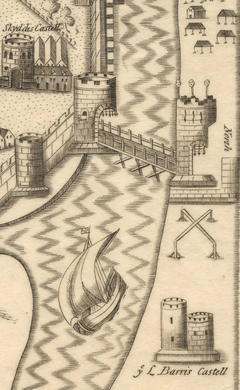Shandon Castle, originally known as Lord Barry's Castle, was an early medieval castle in the Shandon area of Cork city in Ireland. It was built in the late 12th century by Philip de Barry,[1] close to an earlier ringfort.[2] Located outside the city's gates and defensive walls, the castle was a seat of the Cambro-Norman de Barry family for several centuries.[3][4]

From the late 16th century, Shandon Castle became an official residence of the President of Munster, and a "centre of English administration" in the area.[3] In the early 17th century, during the Nine Years' War, a number of Gaelic Irish lords (and their supporters) were imprisoned there by then President George Carew.[5][6] Some of those held here, including James FitzThomas FitzGerald and Florence MacCarthy Mór, were later transferred to the Tower of London.[6] Others, like Dominic Collins who was imprisoned here after the Siege of Dunboy, were later executed.[6]
Early 17th century maps show the castle as a "two towered structure" with a surrounding bawn wall.[2][7] A late-17th century description refers to it as "a large round tower with 16 guns and a good entrenchment".[3]
Used by the court of James II during his time in Ireland in 1688,[3] Shandon Castle was destroyed (along with much of the city) during the Siege of Cork in 1690.[8] Abandoned thereafter, red sandstone from the castle ruin was later used in the construction of the nearby Church of St Anne (built 1722).[9][10] A monastic Dominican order occupied the castle site in the late 18th century, until it was purchased by a committee of merchants in the 19th century.[3] A mercantile exchange building (now known as the Firkin Crane and associated with the nearby butter market) was built on the site in 1842.[11] No standing structures of the castle remain.[12]
See also
editReferences
edit- ^ Lewis, Samuel (1837). "Cork History". A Topographical Dictionary of Ireland. Lewis.
- ^ a b "History Trail, Shandon Street Area". corkheritage.ie. Retrieved 28 January 2021.
- ^ a b c d e "History of Shandon". Cork Past and Present. Cork City Libraries. Retrieved 28 January 2021.
- ^ Windele, John (1846). Historical and Descriptive Notices of the City of Cork and its Vicinity (PDF). Cork: Bolster. p. 7.
The Barries were at this time a powerful family, extra muros, but were allowed no footing in the City, they held a strong Castle of Shandon in the north suburbs
- ^ Dwyer, James (1897). "Permanent Influence of the Religious Orders" (PDF). Journal of the Cork Historical and Archaeological Society. 2. 3 (31): 298.
Shandon Castle was built soon after the Conquest by one of the lords of Barrymore [..] Courts for criminal cases were frequently held there by the lord president and the judges on circuit. Persons obnoxious to the government were likewise imprisoned there
- ^ a b c Collins, J. T. (1943). "Military Defences of Cork" (PDF). Journal of the Cork Historical and Archaeological Society. 2. 48 (167): 64.
- ^ "A description of the Cittie of Cork/ Plan of Cork" (PDF) (Map). George Carew. 1602. Archived from the original (PDF) on 8 October 2021 – via TCD (Hardiman).
- ^ Bracken, Gregory; Bracken, Audrey (2018). Cork Strolls: Exploring Cork's Architectural Treasures. Gill & Macmillan. ISBN 9781788410403.
Shandon Castle, which was built in the late twelfth century by the Barrymores [..] was destroyed during the Siege of Cork in 1690
- ^ "Shandon Steeple". cork-guide.ie. 10 October 2019. Retrieved 28 January 2021.
- ^ "Iconic church steeple undergoes emergency repair work". independent.ie. Independent News & Media. 26 April 2018. Retrieved 30 January 2021.
- ^ "The Firkin Crane Centre, O'Connell Square, Cork City, Cork". buildingsofireland.ie. National Inventory of Architectural Heritage. Retrieved 28 January 2021.
- ^ Archaeological Inventory of County Cork. Volume 2: East and South Cork. Dublin: Government Stationery Office. 1994. ISBN 0707603234.
Shandon Castle; mentioned in Barry's 1531 grant and named 'Ye L. Barris Castell' on Pacata Hibernia map (c. 1585–1600) [..] Hardiman (c. 1601), Philips (1685) and Storey's (c. 1690) maps locate castle near where the Old Butter Market now stands. [..] No visible surface trace